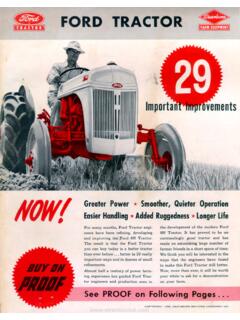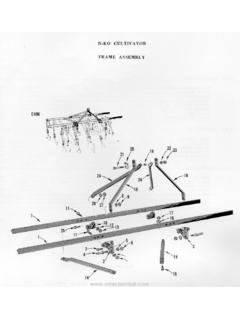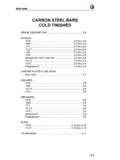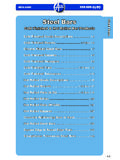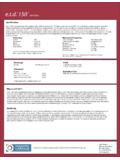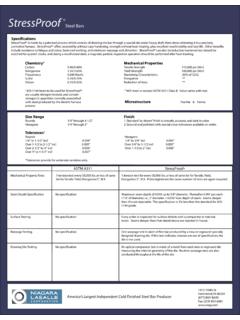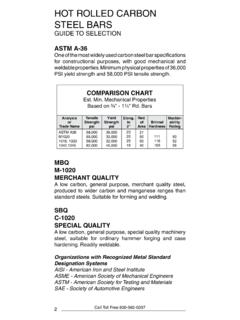Transcription of How To Install Stabilizer (Anti-Sway) Bars On Your …
1 How to Install Stabilizer ( anti - sway ) bars on Your N-Tractor Stabilizer bars are used to prevent side-to-side sway in the implement attached to your 3-point lift. They are not generally recommended for tillage equipment (plows, harrows, cultivators), but work very well for carry-all's, pallet forks, rear scoops, post hole diggers, mowers, rear blades and other implements that work more effectively when locked directly behind your tractor. Some people only Install one Stabilizer bar and feel this works well and reduces hook-up hassle because you have one less thing to align with and attach to your 3-point lift. Others like the security of having two Stabilizer bars in place.
2 Stabilizer bars generally come in a kit that consists of the following components: One L-bracket per Stabilizer bar to be installed. It is installed under a rear axle, using the same bolts that attach the fender to that axle. Note: the existing bolts that attach your fender will most likely be too short to also attach the L-bracket. You will need to purchase bolts that are " 1" longer, as they are not generally included in the kit. The current bolts that attach your fenders should be 5/8" x 6" carriage type bolts. You may not be able to find carriage type bolts and will instead need to buy 5/8" x 7" hex-head bolts at your local hardware store. One short, Category-1 pin, per Stabilizer bar to be installed, that bolts to one L-bracket.
3 Note: the Category-1 pin faces inside, towards the tractor, and must be aligned directly across from the pin upon which the lift arm pivots, to prevent binding when the Stabilizer bar is lifted in tandem with the lift arm. One keeper chain and lynch pin, per Stabilizer bar to be installed, that is used to lock one end of one Stabilizer bar to the Category-1 pin attached to an L-bracket. The free end of the keeper chain is attached to the tractor via the fender mounting bolts, and the lynch pin is used to lock one end of a Stabilizer bar to the small, Category-1 pin attached to the L-bracket. One Stabilizer bar (at a minimum), two to stabilize both lift arms. Typically, one end of the Stabilizer bar is flattened; the other will have a slight curve outward.
4 The flat end attaches to the short, Category-1 pin attached to an L-bracket. The curved end attaches to the lift arm pin, with the curve facing outward, away from the tractor. Installation Steps: Unbolt one fender-mounting bolt and replace it with the longer one you purchased and direct it through one corresponding hole in the L-bracket. Attach the end of the keeper-chain that does not have the lynch pin attached to the fender-mounting bolt. Place a lock washer on the fender-mounting bolt and hand-thread a 5/8" nut onto the bolt, but do not tighten at this time. Do this with the second bolt, but leave both finger-tight. The L-bracket is oriented so that the inside of it faces towards the tractor, not the wheel.
5 The two short pins in the small plastic bag go through one L-bracket each, with the lynch pin end pointing to the middle of the tractor. Here's the important part - the small pin must be directly aligned with the pin through the lift arm, or the Stabilizer bar will bind and the lift arm will win when they do and bend your Stabilizer bar. Eyeball it, or run a straight edge ruler across from the lift arm pivot point to help you line up the Stabilizer bar pin and tighten down the small, Stabilizer bar pin. Once aligned, securely tighten nuts that retain the fender-mounting bolts. After tightening them, re-check to ensure that the short, Category-1 pins on the L-brackets are still in a direct line across from the pins that hold the lift arms to the tractor.
6 When you finish this on both sides, you will have both fenders remounted with slightly (3/4' 1") longer 5/8" bolts, with one L-bracket attached under each axle, with the inside of the L-bracket facing towards the rear axle. A keeper-chain will be attached to each fender-mounting bolt. Both L-brackets should have a short, Category-1 pin bolted to it. Attach the Stabilizer bar by attaching the flat end of the bar to the short, Category-1 pin on the L-bracket and secure with the lynch pin on the end of the keeper chain. The other end of the Stabilizer bar will attach to the corresponding Category-1 pin on whatever implement you choose to hook up, and will be outside of the lift arm (attached last).
7 Here's an 8N with Stabilizer bars installed and used to stabilize a bush hog: Best internet source of information and help for old Ford tractors.



